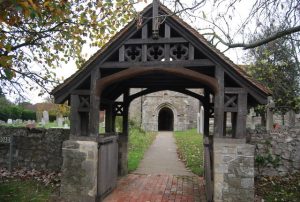
The Village
A Thousand Years of Division
The village of Kirkby Sutton is a conglomerate and an enigma. Formed by the merging of two villages that had outgrown their ability to remain separate as an entity, it nevertheless retains two extremely different and specific identities. One half, as its name suggests, is built around the church and is a (mainly) well-to-do haven of respectability with its Georgian Manor, leafy wide-verged streets lined with large, detached houses, driveways, off road parking and a library. There is also a small 1960s estate, a mix of three bedroomed, privately-owned houses, with an enclave of housing association tenants bolted on for political expediency.
Down the hill, the other half of the village contains a higgledy-piggledy, hotchpotch of stone cottages, modern town houses and rows of Victorian terraces, originally built for the employees at the local lace factory, brewery and estate workers, who made the short trip up the road to toil on the farms of Lord Beresford on the other side of the village. Nowadays, the descendants of those workers still live in the red brick terraces but are mostly employed by industries in the nearby cities of Nottingham and Derby.
The rivalry of its residents compares to any found in much larger towns and cities. You would be hard pressed to find as much animosity at a local Derby football match in Liverpool or Manchester. The annual village fair, which includes a fiercely fought tug-of-war competition, held on a boozy bank holiday weekend, regularly turns violent. For years, a police sergeant from the small town of Higton was paid to referee the event, but when the ageing sergeant retired and the police station was closed down to save money in the 1950s, the residents were left to sort out their own mess, so a committee, made up of the vicar’s wife and a group of teetotal residents from both sides, sat in sober judgment over the proceedings. To this day, the committee still rules on complaints and accusations made by one side against the other. Most of the grievances are easily dismissed, but on a few occasions a vote has to be taken with the chairperson, a lady with no connection to either side of the village holding the casting vote.
Sutton is the older part of the village and dates back to Saxon times. Its name comes from the Anglo-Saxon term for South town (village, or enclosure). It was built on the plain at the bottom of a long slope on the bend of a fast-flowing stream. They built a timber church, which, in bad winters, became a flood plain. Sick of paddling to church for their religious instruction, they erected another one, higher up the slope using the soggy timbers from their original construction.
A hundred or so years later the Danes arrived, but instead of rape and pillage, the Vikings merely appropriated the land around the church and began to farm it. This community became known as Kirkby or the settlement by the church. Over time, the Danish intruders became Christianised, improved the church building and appointed one of their own number, a man from the nearby town of Derby, as priest. They reluctantly allowed their near neighbours to attend religious ceremonies in an effort to re-Christianise the local population who had, by now, become almost universally heathen.
The church was rebuilt in stone during the thirteenth century when the new Lord of the Manor, a distant relative of King Henry III was granted all of the lands around the area. Residents of Sutton sent emissaries to their new lord demanding a church of their own. The lord’s response was to add an extra tax on the ungrateful villagers, a tax that the residents of Kirkby were excused. The Sutton inhabitants were outraged and set about building their own place of worship on the site of the original timber church but on the eve of its consecration, it mysteriously burned down. A second attempt was made a year later but with the same result. Suttonians smelled a rat and protested outside the stone church at Kirkby before Evensong. The parish priest dismissed their grievances and told them in no uncertain terms that both instances of arson were acts of an angry God and if they didn’t start attending his sermons, they would be branded heretics and burned at the stake.
This threat worked to a degree, but there was always an undercurrent of hostility inside the parish.
Sutton attempted to build their church on no less than twelve occasions over the following two hundred years with the same fiery result. When, at last, an Abbey was built on their half of the divide in the late 15th century, their joy was unbridled. That joy was soon to be bridled again however, as in 1538 under instructions from Henry VIII, the building was demolished and the land and possessions seized by the crown.
Sutton decided that God really didn’t intend them to have a church and reluctantly fell in with their Kirkby hosts, which was a good job really as a hundred or so years later, local Aldermen decided that it was too much of the job administering two villages, so they combined them in a covenant and changed its name to Kirkby Sutton. The villagers only learned of this at the next census, and by then it was too late to do anything about it.
The villages expanded in the 18th century to accommodate the newly built mill on the Sutton side of the boundary and the mill owner’s needs on the Kirkby side. New dwellings to house the relatives and administrators of the fledgling industry were built in Kirkby, whilst rows of stone cottages were erected in Sutton, meaning the dividing line between the two halves became ever closer.
When the mill closed in the mid-Victorian era it was turned into a lace factory. Next door, the new owners also built a tannery. These budding entrepreneurs were soon followed by Barton’s Brewery who took the crystal-clear waters of the stream to make their distinctively flavoured ales. Four streets of terraced housing were built on the southern edge of Sutton. The dwellings came complete with individual, outdoor lavatories and a series of communal water pumps. The larger houses of Kirkby, in general, became equipped with their own water supplies, albeit fed from a pump in the kitchens. This led to a near riot one summer when fuelled by a small outbreak of cholera in Sutton, the residents crossed the border (a line of skinny, pine trees) and begged their richer, and less smelly, neighbours for clean water. The gentry refused, so fuelled by the cheap, but strong ale supplied by the new Barton’s Brewery public house, the Suttonian men invaded the north and smashed up the main pumping station that fed the privately-owned houses. The newly-formed Borough Police Force were summoned, the riot was quelled and a raid was made on ‘suspect’ houses in Sutton. Several arrests were made, including that of a wheelchair bound lady of 75 years who hadn’t left her home in a decade.
During the first world war, an uneasy peace ensued with both sides of the village losing men in the fields of Flanders. When the war was over it was decided that a small cenotaph would be built. The Kirkbyans wanted it to be outside the church. The Suttonians, outside the Tannery. A compromise was arrived at, and the stone cenotaph was built on the dividing line between the two halves of the village. By now, this line was imaginary, as houses had been erected on both sides and a tarmac road ran straight through the middle, connecting to a main road at the top end of Kirkby. An uninformed outsider would never have known the villages had ever been separate.
Typically, a row ensued over which side of the construction the names of the dead would be chiselled into so, sensibly for once the Sutton names were carved facing the south and the Kirkby ones facing the north. Every year, on armistice day the residents line up on either side of the tribute to remember their own. Villagers divided, even in death.
Our story begins in August 1950





Leave a Reply